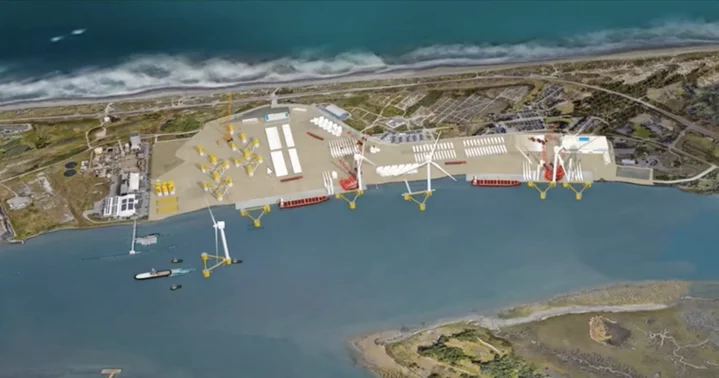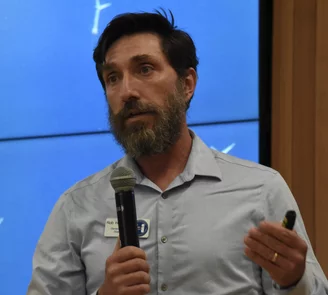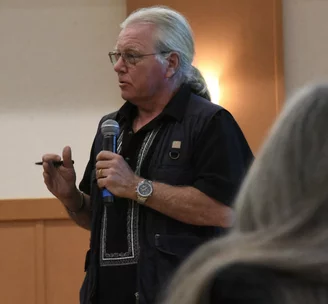Around 200 hundred community members filled the Sequoia Conference Center on Tuesday to take a gander at a draft simulation of the heavy-lift marine terminal project in action. | Photos: Isabella Vanderheiden.
###
In about six years time, massive floating wind turbines – nearly as tall as the Eiffel Tower – could line the shores of the Samoa Peninsula.
At a special meeting on Tuesday, staff with the Humboldt Bay Harbor, Recreation and Conservation District unveiled a draft simulation showing how the Humboldt Bay Offshore Wind Heavy Lift Marine Terminal – the staging and integration facility where the gigantic wind turbines components would be fully assembled – would transform our view of the bay.
The floating turbines slated for the Humboldt Wind Energy Area, located roughly 20 miles west of Eureka, would be among the largest in the world, according to Harbor District Development Director Rob Holmlund. Each turbine tower would be mounted on a floating triangular platform, itself measuring 100 feet tall and up to 425 feet long per side. The turbine would stand at roughly 1,000 feet – about the size of the Eiffel Tower – from the ocean surface to its wing tips. Each blade is as long as a football field.
A digital rendering of the fully built-out Humboldt Bay Offshore Wind Heavy Lift Marine Terminal. Image courtesy of the Harbor District.
“These are the dimensions of the turbines that you’ll see in the simulation,” Holmlund said at Tuesday’s meeting. “We decided to go with a more conservative approach and simulate a more significant potential impact. … The most important dimension here is the floating foundation. You really can’t get any bigger with our project than 425 feet inside of that triangle. … There may be future simulations where you see something smaller, but it’s unlikely that you’ll see simulations bigger than what we’re about to show you.”
Out of 137 potential simulation locations around Humboldt Bay, Harbor District staff narrowed it down to six to “represent different orientations and distances,” Holmlund said. The simulation includes views from the Eureka Waterfront at Livin’ the Dream Ice Cream, the parking lot at the Arcata Marsh, Manila Park on the north end of the Samoa Peninsula, the USS Milwaukee Memorial directly across State Route 255 from the project site, Fort Humboldt State Park and Table Bluff County Park.
Holmlund clicked through each simulation, as seen in the video below, starting with a current view of the project site. With each click a red crane appeared, then a turbine under construction and, finally, a completed turbine. A woman in the audience could be heard whispering, “This makes me sick.”
“It’s important to note that a sunny day is needed for you to see this project from a particular distance,” Holmlund said. “Another thing to consider: throughout the vast majority of Eureka and Arcata you won’t be able to see this project because of buildings. … The general rule of thumb is if you can see the smokestack, you’ll be able to see the project.”
Once the heavy-lift terminal is fully operational, which could be as soon as late 2029, Holmlund said the facility would have the capacity to assemble two turbines per week. The turbines will hang out in wet storage for an undetermined amount of time until they’re ready to be towed out to sea.
“From there [the turbines] can either go to Morro Bay, Oregon, or the Humboldt lease areas,” Holmlund said. “Once it leaves Humboldt Bay, that’s the end of our part of the project.”
Holmlund noted several times during his presentation that the simulation was preliminary and subject to change. For example, this simulation did not depict the district’s plans for wet storage.
During the Q&A period, several community members asked about the lifespan of the project and whether it would be rendered useless once the wind turbines were assembled.
“With California’s offshore renewable energy goals, as well as Oregon and Washington, it’s likely that there will be multiple decades of construction of wind turbines [in Humboldt Bay],” Holmlund said. In addition, wind turbines that are already out in the ocean will need to be towed back into the bay periodically for maintenance. “It will be an ongoing project. … It can also be used for other projects in the future.”
Others asked what the Harbor District is doing to mitigate the noise associated with the project. “Will [the facility] be operating 24 hours a day?” one audience member asked. “When forklifts are operating they make that ‘beep, beep, beep’ noise when they’re backing up. I want to hear about that.”
In short: It’s a work in progress.
“It is possible that the project could be 24/7 operations,” Holmlund said. “We are evaluating sound walls to minimize sound impacts. We are also holding a number of neighborhood-specific meetings with people who live been close by … . And yes, the industrial facility will have backup beepers. We’re still conducting noise studies, and that’ll be part of what we’ll release in a couple of months.”
Audience members also brought up concerns about soil testing and the “toxic sludge” buried deep in the bay. Holmlund said the district will take samples of the dredge material, which will be sent off to various regulatory agencies for “complex chemical analysis,” but emphasized that the project will not require the district to deepen or widen existing channels in the bay.
“If there is contaminated material … then it has to be disposed of at a special landfill, but we’re not anticipating that,” he continued. “To my knowledge, there haven’t been any large dredging events in Humboldt Bay that were heavily contaminated. I’m not an expert on that but we have a world-class consultant specialized in that work.”
Someone else in the audience asked if the entire project would be scrapped if former President Donald Trump were to win the upcoming election. On several occasions, Trump has said he would stop federally-led offshore wind development projects “on day one” of his presidency.
“Could a different president alter the trajectory of this? Probably,” Holmlund said. “California is still going to have its renewable energy goals, but the federal grants that we got [could] be rescinded by a change in the administration. It’s a possibility but climate change isn’t going to stop and we have to find some sort of renewable energy path forward.”
During the public comment portion of the meeting, several audience members asked the Harbor District to pump the brakes on the project.
“I think you’re going too fast on this, and when you go to fast, things can happen,” said former Wiyot Tribal Chair Ted Hernandez, who noted that he was speaking as a Wiyot man, not as a member of the tribal council. “You don’t know what’s going to happen 20 years from now, you don’t know what’s going to happen to our bay, but I have to protect it because of Tuluwat. That’s our home. And when we’re doing ceremony, I don’t want to see these big towers overhead because then our prayers won’t get answered and lifted up to Creator. … I think there needs to be more studies before we push this forward.”
Others expressed concern that Humboldt County is just being used as a “guinea pig” for offshore international offshore wind developers. Some spoke to the greater issue of climate change and the need for a diverse array of renewable energy resources.
“In the United States, we burn a billion tons of coal every year. Every single year. That translates into over three million tons of carbon dioxide going into the atmosphere,” said local resident Matthew Socha. “Coal is absolutely the dirtiest, worst, most poisonous form of electricity we’re producing. Anything we can do to take a bite out of that [industry] is going to be helpful. … It will take a combination of things and different alternative resources. This [project] is a part of the puzzle.”
Matt Simmons, a climate attorney with the Environmental Protection Information Center (EPIC), acknowledged that there are many, many questions surrounding the port project and offshore wind development as a whole. “Everyone is still learning.”
“I think it’s actually super helpful and important that we’re having these visualizations so early in this process to help us learn as much as we can about this project,” he said. “I’m hearing a lot of questions from everyone about offshore wind, and you’re not alone. It’s different.”
EPIC, in partnership with the Redwood Region Climate and Community Resilience (CORE) Hub and the Humboldt Waterkeeper, recently launched a website to help answer some of the community’s questions about offshore wind development. Simmons urged attendees to check it out. “I’m not saying you have to support or oppose the project. What I’m saying is let’s all get educated.”
Check out the video below for Holmlund’s full presentation. More information on the heavy-lift marine terminal project can be found here.
###
###
PREVIOUSLY:
- Harbor District Announces Massive Offshore Wind Partnership; Project Would Lead to an 86-Acre Redevelopment of Old Pulp Mill Site
- Offshore Wind is Coming to the North Coast. What’s in it For Humboldt?
- ‘Together We Can Shape Offshore Wind for The West Coast’: Local Officials, Huffman and Others Join Harbor District Officials in Celebrating Partnership Agreement With Crowley Wind Services
- Crowley — the Company That Wants to Build a Big Wind Energy Facility on the Peninsula — Will be Opening Offices in Eureka
- Harbor District to Host Public Meeting Kicking Off Environmental Review of Offshore Wind Heavy Lift Marine Terminal Project
- Humboldt Harbor District Officials Talk Port Development As Offshore Wind Efforts Ramp Up
- County of Humboldt, Developers Sign Memorandum of Agreement in a ‘Momentous Step Forward’ for Offshore Wind Development on the North Coast
- Harbor District Responds to Crowley Controversy, Commits to the ‘Highest Ethical Standards’
- LoCO Interview: The Outpost Talks to Crowley Executives About Recent Allegations of Misconduct, Port Development on the Samoa Peninsula and the Company’s Future in Humboldt
- Harbor District Board of Commissioners to Discuss Proposed Offshore Wind Terminal Project, Lease Agreement With Crowley During Tonight’s Meeting
- (UPDATE) Huffman Announces $8.7 Million Federal Grant Toward Offshore Wind Port Development
- Harbor District Commissioners to Discuss Extended Partnership Agreement with Crowley Wind Services During Tonight’s Meeting
- WHOA: Rep. Huffman’s Office Teases $426 Million Federal Grant for Offshore Wind Terminal, to be Announced Tomorrow
- (PHOTOS) The Biggest Federal Grant in Humboldt History? Huffman, Assorted Worthies Gather on Woodley Island to Celebrate $426 Million in Infrastructure Funding for Offshore Wind
- At a Two-Day Conference in Eureka This Week, North Coast Tribes Advocate for ‘Meaningful Engagement’ With Offshore Wind Developers, Federal Regulators
- Crowley Wind Services’s Partner Agreement With the Harbor District Will Expire Without a Lease, Leaving Future Relationship Unclear




CLICK TO MANAGE